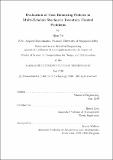| dc.contributor.advisor | Restef Levi. | en_US |
| dc.contributor.author | Yu, Qian, S.M. Massachusetts Institute of Technology | en_US |
| dc.contributor.other | Massachusetts Institute of Technology. Computation for Design and Optimization Program. | en_US |
| dc.date.accessioned | 2010-08-26T15:23:25Z | |
| dc.date.available | 2010-08-26T15:23:25Z | |
| dc.date.copyright | 2010 | en_US |
| dc.date.issued | 2010 | en_US |
| dc.identifier.uri | http://hdl.handle.net/1721.1/57550 | |
| dc.description | Thesis (S.M.)--Massachusetts Institute of Technology, Computation for Design and Optimization Program, 2010. | en_US |
| dc.description | This electronic version was submitted by the student author. The certified thesis is available in the Institute Archives and Special Collections. | en_US |
| dc.description | Cataloged from student submitted PDF version of thesis. | en_US |
| dc.description | Includes bibliographical references (p. 67-68). | en_US |
| dc.description.abstract | We study a periodic-reviewed, infinite horizon serial network inventory control problem. The demands in different periods are independent of each other and follow an identical Poisson distribution. Unsatisfied demands are backlogged until they are satisfied by supply units. In each period, there is a per-unit holding cost is incurred for each unit of supply that stays in the system and a per-unit backorder cost is incurred for each unsatisfied unit of demand. The objective of the inventory control policy is to minimize the long-run expected average cost over an infinite horizon. The goal of the thesis is to evaluate the empirical performance of the dual balancing policy and several other variants of cost balancing policies through numerical simulations. The dual-balancing policy is based on two novel ideas: the marginal cost accounting scheme, which assigns to each decision all the costs that are made inevitable after that decision is made; and the cost balancing idea to balance opposing costs. | en_US |
| dc.description.abstract | (cont.) The dual-balancing policy can be modified in several ways to get other cost balancing policies. It has been proven that the dual-balancing policy has a worst-case guarantee of 2 but this does not indicate the empirical performance. An approximately optimal policy is considered as the benchmark to test the quality of the cost balancing policies. In the computational experiments, the dual-balancing policy shows an average error of 7.74% compared to the approximately optimal policy, much better than the theoretical worst-case guarantee. The three variants of cost balancing policies have made significant improvement on the performance of the dual-balancing policy. The accuracy of the dual-balancing policy is also affected by the system parameters. In addition, with high demand rate and long lead times, we have observed several scenarios when the cost balancing policies dominate the approximately optimal policy. | en_US |
| dc.description.statementofresponsibility | by Qian Yu. | en_US |
| dc.format.extent | 68 p. | en_US |
| dc.language.iso | eng | en_US |
| dc.publisher | Massachusetts Institute of Technology | en_US |
| dc.rights | M.I.T. theses are protected by
copyright. They may be viewed from this source for any purpose, but
reproduction or distribution in any format is prohibited without written
permission. See provided URL for inquiries about permission. | en_US |
| dc.rights.uri | http://dspace.mit.edu/handle/1721.1/7582 | en_US |
| dc.subject | Computation for Design and Optimization Program. | en_US |
| dc.title | Evaluation of cost balancing policies in multi-echelon stochastic inventory control problems | en_US |
| dc.type | Thesis | en_US |
| dc.description.degree | S.M. | en_US |
| dc.contributor.department | Massachusetts Institute of Technology. Computation for Design and Optimization Program | |
| dc.identifier.oclc | 640141077 | en_US |
